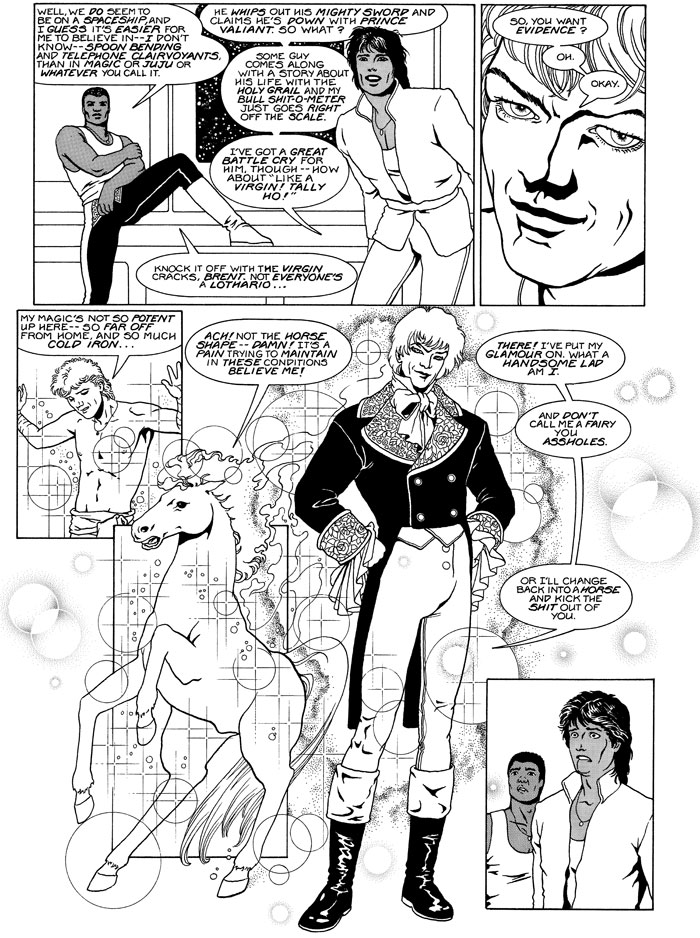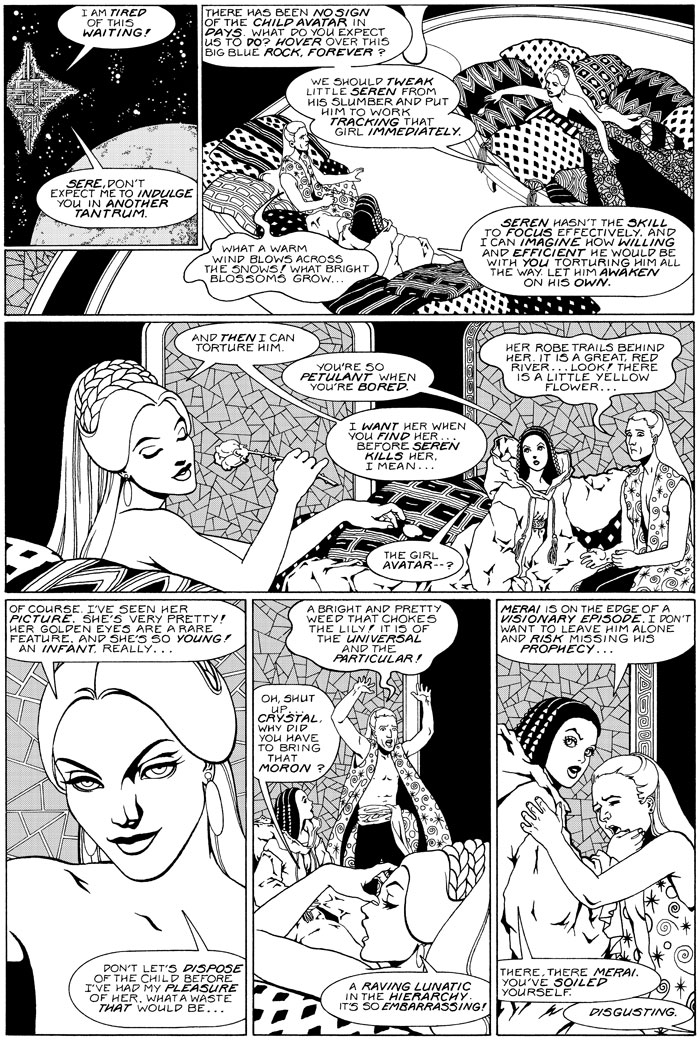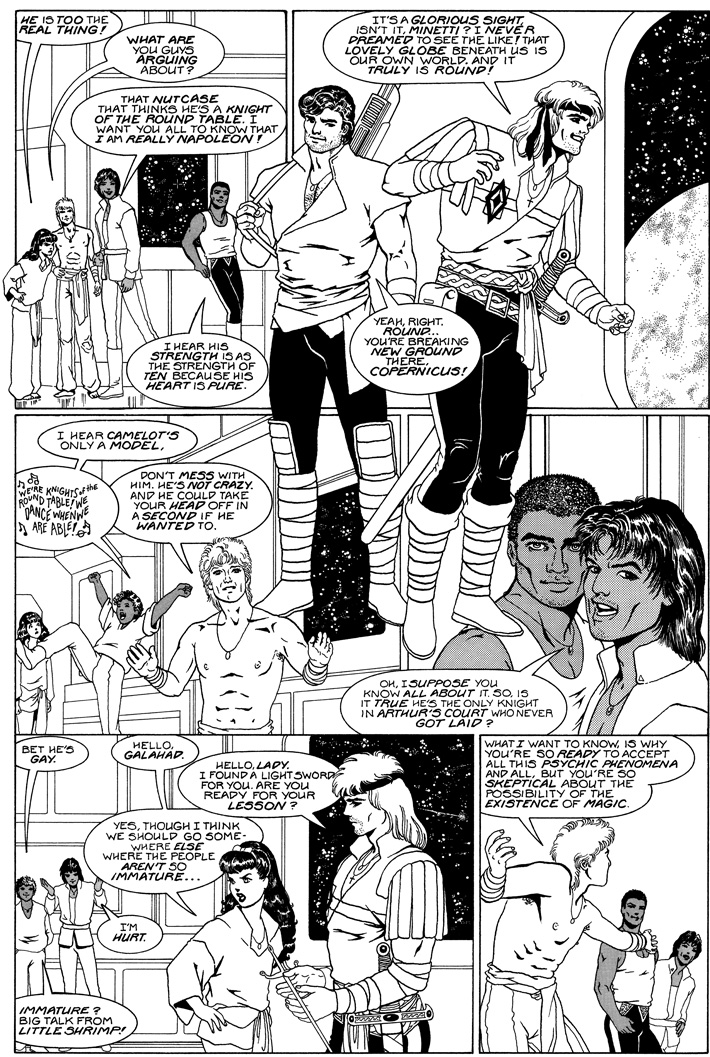
A DISTANT SOIL: The Ascendant Chapter 3 Page 14
First and foremost, my sincere appreciation to Robert Pincombe for his noble sacrifice of dollars on the altar of A Distant Soil.
Robert popped us a donation after reading VERY BAD PUBLISHERS, which I continually flog, not just for my benefit but for yours. If you consider getting into the art and entertainment profession (any area, including webcomics,) I really wish you would take the time to read about my experiences. The posts start off a bit slow, but I go into detail about contract scams and other publishing pitfalls.
And in other happy news, the restoration process is a lot speedier now that I have learned to use the polygonal lasso tool. As of yesterday.
By the way, a question for the grammarians out there, because I never had two editors on the print edition who could seem to agree. And when I finally do a super duper definitive edition, I would love to have clean copy.
A word balloon is comic book language for quote. Many editors use double quotes when quoting inside a word balloon. Except if a quote is within a quote, that should be single quotation marks, right? Or not?
And what about titles? Should I just bold them or use quotes? As you see, Brent makes a really lame crack in panel one, and I am at sea as to how to properly do the quote deed.
And I can say Brent’s dialogue is lame, because I wrote it. Man, what a dopey line.
Thoughts? About the grammar, I mean. OK, if you want to comment about Brent’s lame quote, that’s OK, too.



17 Comments
scribblerworks
If it were me editing, I would say use the double quotation marks within the balloon. Because a comic book page is a special thing, visually. It’s not like straight text. I think psychologically we regarding the balloon as if it were really spoken, and that therefore when a speaker quotes something, it is as if it is a “first level” quotation.
That’s my take, at least. 😀
Colleen
Good comments. I am interested in hearing from all sides of this issue.
FYI, I had just started using Japanese tone sheets shortly before I drew this page, and the delicate stippling is a combination of hand drawn work and tones.
Arlnee
I agree. Double quotes in a word balloon would make sense.
I would also say use quotes for titles, because bold is used to make points in speech, whereas in text it would be italics. And since italics are hard to convey in hand lettered lettering–even in some type faces–to use bold would be construed as being emphasized, but not titled.
At least that’s what I’ll do, when I run the zoo 😉
Allan
Doesn’t really matter as long as you’re consistent in the usage. I wouldn’t use quotation marks for titles though, I think that reads as rather old-fashioned. I’d go either for bold or italic. Generally speaking the reader can discern that a titled work is being referenced from the context of the speech as a whole.
Colleen
Single quote is British, right?
So if it’s not incorrect, I can leave it at that. I think most of the book uses single quotes.
Allan
Works for me.
How about putting a ‘u’ in colour and favourite? And ‘pavement’ instead of sidewalk? Keep the British end up, I say. 🙂
Colleen
I’d say if it is incorrect to use British punctuation and US spelling, then I can only use one or the other, and it is easier to change the punctuation than the spelling!
Does anyone know?
And I’m not sure I agree with the idea that the word balloon shape is not a quotation mark. If that’s the case, then every quote within the word balloon would have to have quotation marks around it.
My thinking is that the word balloons are the quotation marks. So, the quote within a quote would be single, not double.
And I’m wondering if anyone has come up with a comic book grammar primer! LOL!
Arlnee
I have seen webcomics where people put quotation marks around the dialog in word balloons. All of them. I find that annoying.
As long as you don’t start doing that, it’s fine. 🙂
scribblerworks
Colleen, yes, single quote marks first is British usage – the reverse of American style.
Originally, I had a whole speculation on why, but since I don’t really know (it would require a little research 🙂 ) I won’t indulge in it. But certainly, you can let yourself off the hook by saying you used British punctuation.
Regarding titles, I’d say it depends on how you feel about the look of italics on the comic page. I would definitely leave bolding for emphasis. On JEOPARDY!, because our Chyron didn’t do italics, we would put quote marks around all titles (novels, songs, stories, movies, etc.).
Allan
“And I’m not sure I agree with the idea that the word balloon shape is not a quotation mark. If that’s the case, then every quote within the word balloon would have to have quotation marks around it.”
If you’ll forgive me for saying so, I think you’re worrying rather too much about this. What you’ve done so far has been absolutely, perfectly fine. There are no grammar police waiting in the wings to pounce on a misplaced semi-colon. And even if there are, screw ’em: this is comics — we have our own rules.
Colleen
LOL! I forgive you for saying so!
I am thinking of a future edition which will be in libraries for years to come. I want to make sure it’s the best I can do. And details matter to me.
But I think your point about being consistent eases my mind. I will use the single quotation marks, since that is what predominates.
Laurie Sutton
According to both The Associated Press Stylebook (used in newspapers and magazines) and The Chicago Manual of Style (used in prose book publishing) double quote marks are used when quoting the exact words of a speaker:
“I meant to do that,” she said.
Single quote marks enclose quotations within quotations:
“I never said ‘I’m confused’ so stop saying I did,” she insisted.
Use three quote marks together if two quoted elements end at the same time. Rules for the placement of the period differ between the two manuals, however, so pick one and stick to it:
“I never said ‘I’m confused.'” (AP Stylebook)
“I never said ‘I’m confused’.” (Chicago Manual of Style)
In comics, word balloons define what a character is saying, but they are not equivalent to quotation marks, double or single. In a comic, double quote marks are used if the speaker is quoting someone or something. Single quote marks are used if there is a quote within that quote.
Main Character: I never said “I’m confused”. I said “I meant to do that”.
Secondary Character: You may have said “I meant to do that”, but you also said “Remember that ‘All’s well that ends well’.” I hope you’re right about that!
Now, when you ask about titles, do you mean titles of books and stories? If so, The Chicago Manual of Style calls for book titles to be in upper and lowercase italics. The title of an article within a larger work is set off with double quote marks and is not italicized. The title of a short story is in double quotes and not italicized. But comics are their own universe in this because the text is primarily all uppercase. I don’t know of any rules regarding book and story title in comics. I never had the opportunity to apply any! My suggestion is to do what looks good and gets your point across to the reader.
So there’s my long answer to your short question.
Colleen
Thanks for your perspective. I also have style manuals, and know how to use punctuation for prose. But comics are not prose.
As you say in your post “comics are in their own universe,” and I think that applies to the use of quotation marks. I think I am going to go with Allan’s advice, and go for consistency.
“Do what looks good and gets your point across…” Good advice. I will.
I’ve learned one thing from this discussion: we’re making it up as we go!
scribblerworks
That’s the nice thing about comics — you can say flatly “It looks best THIS way,” and it really is an arguement ender. It isn’t an academic text publication.
Colleen Doran
UPDATED
Cassie
Anyway Brent’s face in the last panel is now my political commentary reaction image forever thanks
Colleen Doran
LOL! Thanks Cassie!